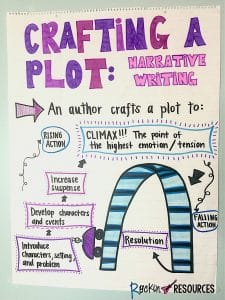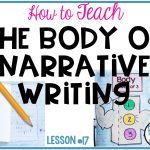Are your students writing stories that are blah? Show them how to build suspense and climax in their narrative writing stories! This post will review plot, show an effective mentor text, and give ideas and activities for building suspense and climax! These ideas are ideal for any writing curriculum and are a part of a series of mini lessons for writer’s workshop designed for scaffolding through the writing process.
Building suspense and climax can be difficult for students. Often times they want to tell the bang of the story right away. Follow these steps:
1. TEACH
While developing the body section of a narrative story, build suspense and climax. An author creates suspense and a climax to a story to keep the readers’ interest. This is one of my favorite lessons in narrative writing! Use a roller coaster like the anchor chart used in our plot lesson.

Discuss the following questions:
What is supsense? It shows feelings of an excited or anxious state.
Why create suspense? It makes the story interesting.
What is a climax? It is the highest peak or excitement in the story.
2. MENTOR TEXT
Revisit Cinderella from the plot lesson. My favorite version is by Sarah L. Thomson.
Start off by introducing Cinderella, step sisters, and step mother. Explain how their characters develop and the mean things they do to Cinderella. Next, explain how the author increases the suspense when the fairy godmother gets involved and Cinderella shows up at the ball. The action rises when Cinderella dances with the prince. The suspense increases even more when the clock strikes 12 and she loses her shoe!!!! The climax is when the prince is looking for the right foot to fit in the shoe. Will Cinderella get to try on the shoe? Will the prince find her?
3. MODEL
Take the story you are working on as a class and model by adding suspense and a climax to it. Talk out loud as you brainstorm and have students chime in.
4. TAKE NOTES
Have students take notes on suspense and climax so they have a reference next time they are developing a narrative story. If your time is limited, make a copy of an anchor chart or the notes you want them to remember and hand it out to your students to keep in a notebook. This is an example of an interactive notebook page for notes.
5. ACTIVITY
Divide students up into groups of four. Place one of the Shared Suspense Writing Prompts below for each student into a cup and pass it around the groups.
1. Hurrying to get home on time, they decided to run through the cemetery to get home faster.
2. Finding a treasure map in the old attic, we decided to follow it.
3. Her computer kept flickering and the next things she saw…..
4. My friends kept staring at me in fear. I turned to look in the mirror to see ….
5. As the boy was swimming in the ocean, he felt something rub up against him.
6. My dog started barking in the middle of the night. I crept down stairs.
7. On the camping trip, the campers realized they were on the wrong trail.
Each person in the group chooses one prompt. When you signal to begin, each person writes an introduction paragraph for the prompt. Give them enough time to write then stop the whole class. Ask them to pass their paper to the left. That person needs to read what the previous person wrote and start the next paragraph adding suspense. The 3rd person needs to build more suspense. The 4th person writes the climax of the story. Share within the small group.
6. PRACTICE
Do your students need more practice, give them more prompts or the ones from the activity that you didn’t use. Work on building suspense and a climax for them in whole group, small groups, or independently.
7. APPLY
Go back to the interactive notebook page and have students add 3 ideas under the flaps for their story. Then they need to transfer those ideas into the body of the paper.
8. SHARE
Students should share their ideas for suspense and climax in their own story. It will add to their excitement and may offer ideas to the reluctant writers in your class.
Check out my FREE writing masterclass! CLICK HERE
LAST LESSON: WRITING MINI LESSON #17- WRITING THE BODY SECTION ON A NARRATIVE STORY
NEXT LESSON: WRITING MINI LESSON #19- DEVELOPING CHARACTERS IN A NARRATIVE ESSAY!
CLICK HERE FOR THE FULL LIST OF WRITING MINI LESSONS
This lesson is also included in the STEP-BY-STEP WRITING® Program with mini-lessons designed to scaffold through the writing process. Writing units included are sentence structure, paragraph writing, narrative writing, opinion writing, and informative writing. See what is included in the image below and click on it to learn more about them! You will turn your reluctant writers into ROCKSTAR WRITERS™!
“I have been looking for a writing curriculum for fourth grade for three years. I like the anchor charts, lesson plans, interactive notebook pages, and the elements included for each writing genre. I love the symbols used, like the bus for transitions the million dollar words. I like how you can take a component and use it separately if needed. So happy to have found this!” -Melissa Q.







